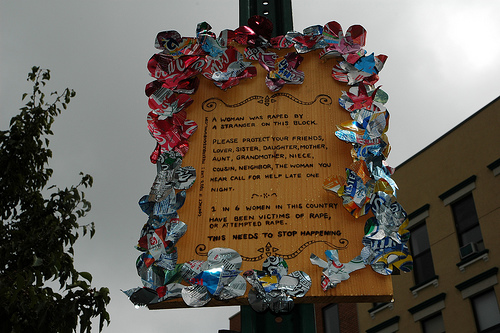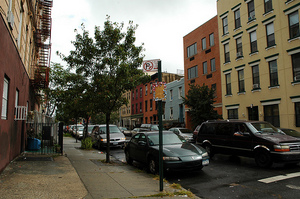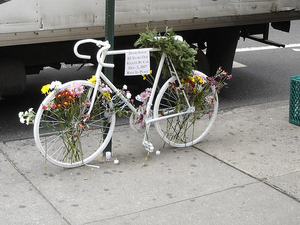This is an archive of the ArtCat Zine, 2007-2009. Please visit our new project, IDIOM.
Re:Public, A Rape Victim Empowers Herself as a Street Artist

At a nondescript corner of Meserole and Humboldt in the eastern section of Williamsburg stands an unusual and what seemed to me consciously-folksy sign bolted to a no parking sign. It reads:
"A woman was raped by a stranger on this block. Please protect your friends, lover, sister, daughter, mother, grandmother, niece, cousin, neighbor, the woman you hear call for help late one night. 1 in 6 women in this country have been victims of rape or attempted rape. This needs to stop happening."
Framing the message, which is burned into a flat piece of wood, is a dense border of flowers made out of aluminum cans. Also on the work is an email address and a shy invitation to reach out to the sign's creator.
I wrote the individual to learn more about this work, a strange meeting of micro-monument, public service announcement and folk art. I received a response from the sign's maker the next day and she agreed to speak to me over email but not in person because she explained: "My case is still in court and i don't want to jeopardize my anonymity."
The circumstances of the crime that was committed against her is chilling. She told me that one day on her way home at 2am she was assaulted as she opened her front door. Forced inside, she was held in her apartment for five hours, raped and robbed her assailants let her go the next morning. Follwing is record of our conversation about the art work that aims to raise awareness about the crime of rape and its impact on a community.
Hrag Vartanian: Who are you? Are you an artist?
Anonymous: I am a 26 year old female living in Brooklyn, where I've lived for the past 4 years. I've been in NYC for 8 years now. I came to New York for art school, and have been developing my studio practice since I graduated 4 years ago. I am a sculptor and installation artist.
HV: Do you consider the sign in north Brooklyn a work of street art?
A: I've honestly never made street art before. I admire a lot of street artists but I have never felt that my own work needed or wanted to be in the streets. It's never been part of the dialogue in my work. I suppose the sign is a piece of street art because it's purpose is to directly communicate with the community, and it's about the community. It needs the context of the street to be successful. I don't think it could exist in the same way in the gallery.
HV: Why did you create it?
A: I had heard about and seen the Ghost Bikes installed around the city, and was really inspired by their idea to memorialize a tragedy with street sculpture. You probably know about them: a broken bike is spray painted-white and chained to a street sign near the location of a cyclist's death. So, I thought of making a sign to create awareness of rape occurrences, to make people realize that it can, and has, happened in their neighbor, or to their neighbors.
HV: What does it mean for you? How has rape affected your life?
A: The rape has effected my life in so many ways, both good and bad. I should tell you that I consider myself very lucky that my health was not harmed in any way, nor do i sustain any physical scars. The most horrifying part about the rape was being so close to another person's inhumanity. For months afterward I questioned why some men think that they have the right to rape. That led me into an investigation of rape as a tool of violence and greed since the beginning of time. The overarching questions still are: why do women have to fear rape, and what has society done to contribute to the formation of rapists?
One of the good things that happened as a result of the rape, was an increased closeness with my friends and my community. It made me focus more on the things that are important to me, and let go of trivialities. It also made me more aware of my safety: I always call a friend if I'm heading home late, and they expect another call when I arrive home safely. I also carry pepper spray with me and keep some in my home.
HV: Tell me about the aluminum cans flowers that frame the wood?
A: The flowers were an idea that a friend had for another project. I like the dialogue that aluminum cans have with the street. Using materials that are instantly familiar to viewers increases their level of engagement with the piece. I was also thinking about the common use of flowers in memorials and in mourning.
HV: Did you burn the words on the sign?
A: I did. I like how permanent wood burning is, and how it amplifies the meaning of the message. It becomes very raw and urgent.
HV: What is your fantasy of what you would like this sign to achieve?
A: It's probably a little ambitious, but I want rapists to realize that the act that they commit is unforgivable, and is an obscene expression of power over another person. I hope that they will come to this realization when they think about the possibility of their loved ones becoming victims of rape. I also hope that other rape victims will contact me to put a sign up in their neighborhood. It is important to spread community awareness, as well as to empower the victims by allowing them to take an active role in preventing it from happening to others.
HV: Rape is a sexual crime that involves highly inappropriate boundaries. Were you conscious of the negotiation of boundaries (public vs. private) that is an integral part of street art?
A: Yes, I think this was the reason it took me over a year to make it and put it up. I was worried people would be so afraid of the subject that they would deface the sign; I'm still worried about this happening. It's equatable to someone just wanting to erase it, to pretend rape never happens. For me, as a victim, it's important to be recognized so that I can heal and recover. I think it can be embarrassing for people to be confronted by the rape sign. Is that something they mind facing everyday? I don't think I'll ever know. Which makes me think of a larger question: how would being daily confronted by the atrocities of this world everyday affect our lives?
A: That's interesting to know that you thought of that when you saw the sign. I can also see the barbed wire quality you mention, which i think comes from the thematic tension between beauty and violence that appears in a lot of my other work. I do believe that my fear manifested itself in the way you mention, though it was unintentional.
However, the experience of putting up the sign was not at all frightening. Three of my best friends came with me, all on bikes, to put the sign up. I was very nervous and wary of getting caught beforehand, but calmed down once we started putting it up. It was much easier than i had anticipated. We went on a beautiful Sunday morning, one friend had the idea to lean our bikes against the sign post to create a ladder so we could hang the sign out of arm's reach, and it went very smoothly. I think it took only a few minutes. We took some pictures of hanging it, and then just rode away. It was very surreal to actually have it done, after imagining it for so long, and i was so grateful to do it with friends.
HV: What has creating this piece of street art taught you? Do you feel about the street differently? Has it informed your studio practice?
A: I think I feel more vulnerable creating street art than i do showing my other work in a gallery. I don't use text in my own work, and doing so in the sign made me realize how direct and powerful words can be, though it also reinforced the success that a more subtle, open-ended piece of work can have. It has made me think more passionately about the street as an opportunistic venue for issues that directly affect the community.
HV: When violence happens to people there is a tendency to vilify a neighborhood or people, that doesn't seem to have happened to you or has it?
A: For a long time after the rape I was angry that none of my neighbors had noticed the struggle or heard my yell for help right outside my front door (a street level apartment). It all happened in a matter of minutes and it was very late at night, but at the time I was incredulous that no one heard. But then my anger shifted to really wanting to protect my neighbors from violence. Also, I had a hard time for awhile dealing with the fear I experienced when i saw men of the the same age and ethnicity as my attackers; I've been told that is normal, and it has lessened a lot in the past year.
HV: Has making this art work helped you to heal?
A: So many things have contributed to my recovery, and I do think the sign project has helped some, especially now having this dialogue with you and others since I put it up. I feel so strongly about affecting people's perception and awareness of rape. I think that this is the way to prevent it from happening.
Something interesting I just learned from my ADA is that until recently defense attorneys in rape cases were allowed to use the victim's sexual history as a way to convince jurors of her promiscuity and deny the charges. At least rape is starting to be taken more seriously in the courts.
HV: What has the reaction been and how many people have emailed you?
A: I've only had a few responses in the the month since posting the sign. Two interview requests (one from you), and some odd spam. I wish I knew what people were saying on the street.
ZINE
HOME
TIPS / COMMENTS
CATEGORIES
CONTRIBUTORS
- Greg Afinogenov
- B. Blagojevic
- Adda Birnir
- Susannah Edelbaum
- Julie Fishkin
- Paddy Johnson
- Jessica Loudis
- Christopher Reiger
- Andrew Robinson
- Peter J. Russo
- Blythe Sheldon
- S.C.Squibb
- Hrag Vartanian


